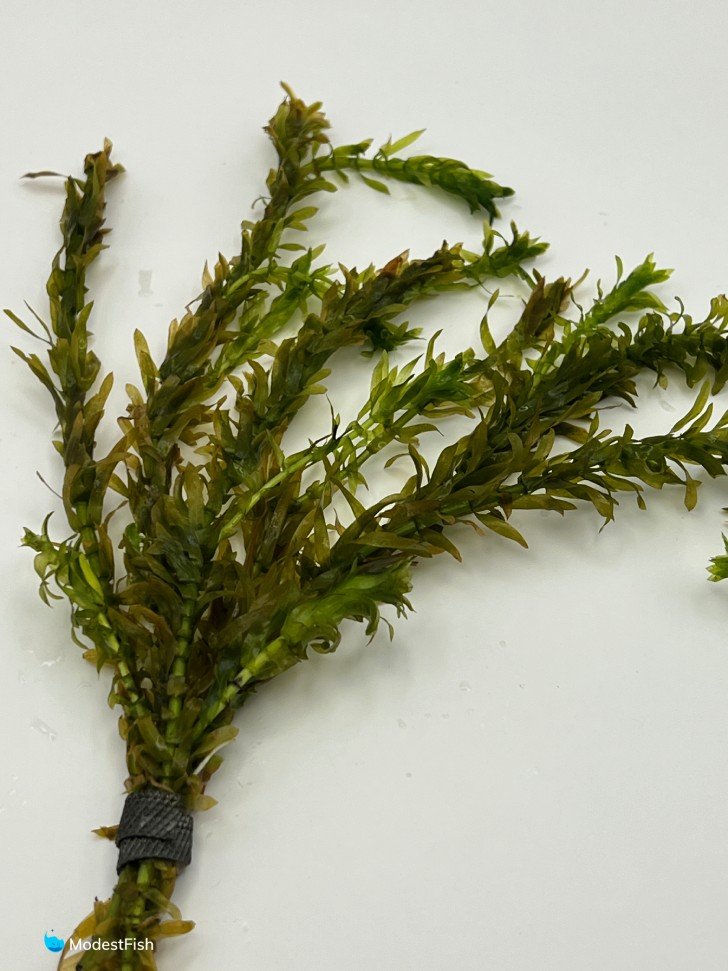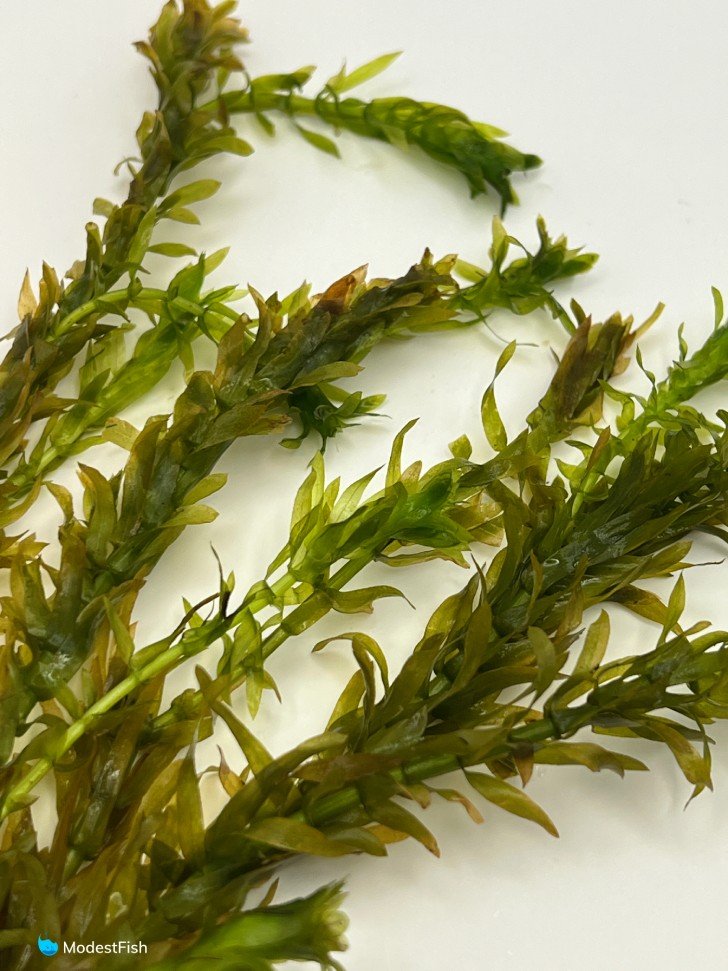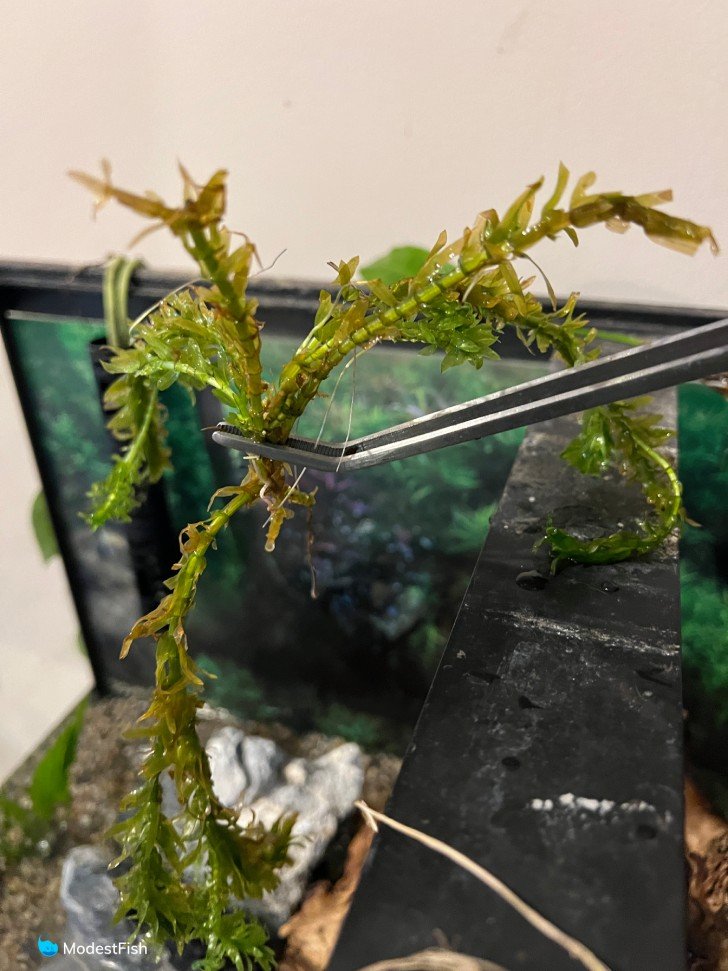Anacharis (Elodea canadensis) is an excellent beginner plant, being able to tolerate just about any aquarium conditions, it helps remove excess nitrate from the water column and it thrives on benign neglect.
In this guide, I’ll teach you how to care for anacharis in your aquarium and which species is most compatible with.
Anacharis Quick Care Stats
- Scientific Name: Elodea canadensis
- Family: Hydrocharitaceae
- Order: Alismatales
- Genus: Elodea
- Care Level: easy
- Growth Rate: fast
- Maximum Size: 24 inches (60 centimeters)
- Water Conditions: pH range of 6.0-8.0, temperature 60°-82°F (16°-28°C)
- Lighting: low-high
- Propagation: cutting
- Tank Placement: background
Table of Contents
Overview: Anacharis (Elodea canadensis)

Elodea canadensis, commonly called anacharis, is a species of waterweed that is native to North America.
It is a fast growing stem plant that is often found floating on the surface of ponds.
Anacharis looks like long ropes of seaweed. It’s not a fancy or ornate plant at all.
The stems are only a few millimeters in diameter. Every half inch or so, sprouts a cluster of three leaves that are about an inch long and shaped like thin, pointed ovals.
If left undisturbed, the stem just grows longer and longer, putting off branches that form their own growth points.
In the aquarium, anacharis is an easy to grow plant that does a great job of removing excess nutrients from the water column.
It’s also a great cover plant for fish fry or ornamental shrimp. Because it can be left to float in the aquarium, it’s a great thing to throw into quarantine or hospital tanks to provide fish with hiding places.
Anacharis is so easy to take care of, as long as it has light, you could just throw it in a bucket and it will grow! They don’t call it waterweed for nothing!
In fact, anacharis is an invasive species in waterways all over the world. It’s illegal in some countries and in several states in the US.
Caring for Anacharis In an Aquarium

This species is exceedingly easy to care for. If anything, you might get tired of trimming it back.
Tank Requirements
Anacharis can be grown in something as small as a 10 gallon (39 liter) tank (you would need to trim it quite often!) or it can eventually grow to a huge size in a large tank, like a 100 gallon (379 liter).
This stuff can cover the surface of a pond, so it will fill whatever space you want.
Water Parameters
- Temperature: 60°-82°F (16°-28°C)
- pH: 6.0-8.0
- dGH: 6-20
This species will do best in moderately hard to hard water. Anacharis prefers a higher mineral content in the water column.
Lighting Conditions
Anacharis can tolerate a wide range of light levels.
It will still grow, even in rather dim lighting. Of course, it will be leggy and not look its best, but it will grow.
The brighter the lighting, the faster and more attractive this species will grow. I would recommend at least low-medium light or higher for it to look its absolute best.
Substrate & Fertilizers
This species does not feed from the substrate. Its roots are mostly anchors that help hold it in place.
Anacharis will happily grow while floating in a bare bottom tank.
So, you can use whatever kind of substrate you want with this species.
Fertilizers are not strictly necessary, but just like with brighter light, fertilizing this plant will make it grow faster, bushier and more brightly colored.
If you have livestock in the tank, like fish, shrimp and/or snails, these should provide all of the nitrate that your anacharis needs.
Simply add in a good micronutrient supplement, like Seachem Flourish Comprehensive, and your anacharis will brighten up and grow across the tank even faster.

Last update on 2024-04-21 / Commissions Earned / Images from Amazon Product Advertising API
Maintenance
Anacharis does require frequent trimming, especially if you keep it rooted in the substrate.
Depending on your light levels, you may find yourself cutting the stems and replanting the tops of the plants back in the substrate once or twice a month.
This can be a bit of a pain, which is why I recommend weighing it down rather than planting it in the substrate, something I discuss in more detail in the next section.
The older growth should be pulled out of the substrate and carefully bagged up and disposed of in the trash. You don’t want it to accidentally get into your local waterways because it can be quite invasive.
The only other maintenance issue with anacharis is keeping it free of algae. Especially since it often grows at the surface of the water, algae loves to grow on anacharis.
The best remedy is keeping algae eaters, like ornamental shrimp or otocinclus catfish in your tank.
You can also spot treat algae using Seachem Excel.

Last update on 2024-04-21 / Commissions Earned / Images from Amazon Product Advertising API
How to Plant Anacharis

Anacharis can be planted in a variety of ways.
It can be grown as a floating plant. It will float at the surface and continue to grow longer and longer, until it covers the entire surface of the tank.
You can also root anacharis down in the substrate. The end that is buried will put out thin, white roots. These roots don’t really absorb nutrients; they just serve to anchor the plant.
But, since you trim off the top of the anacharis, and discard the older growth from the bottom of the plant, I prefer to simply weigh the stems down with rocks or heavy decor items.
That way, I’m not constantly trying to bury the stems down in the substrate every time I go to trim the plants. I just pick up the rock and place it on top of the new cuttings. It makes it so much easier.
How to Use Anacharis in an Aquarium
This plant is mostly used in two main ways: as a floating plant or background plant.
If this species is left to just float at the surface, it will wind around itself and grow in a jumbled tangle.
Anacharis grows very quickly in most tanks, you want it at the back of the tank, so it doesn’t block the view of everything else.
Weighing it down at the back of the tank will let the long stems stream up toward the surface of the water, lending your tank a very natural look.
How to Propagate Anacharis
Propagating this plant couldn’t be simpler.
Just cut off 4 inches (10 centimeters) of the stem and you have a whole new plant. You can just let the cuttings float loose in the tank or you can weigh them down with substrate, rocks or decor.
After a week or so, you’ll start to see a new branch grow out from the original cutting.
Tank Mates for Anacharis
My number one recommendation for anacharis tank mates are any kind of ornamental shrimp, especially Amano shrimp.
Shrimp love to graze along the surface of anacharis, eating algae and detritus that collects there.
Otocinclus catfish are another good choice. This species is great for scouring your tank for algae and uneaten fish food. They really are an awesome little scavenger.
Smaller snail species, like bladder snails (viewed by some as a pest snail) also do a great job at keeping anacharis clean.
Livebearers are another great pairing with anacharis, especially if it’s allowed to float at the surface. A nice tangle of anacharis is the perfect cover for newly born guppy fry, giving them a chance to escape from ravenous adults in the tank.
In the end, this plant is tough and tolerant of adversity, as long as the livestock in the tank doesn’t utterly destroy plants, like large cichlids tend to do, then the anacharis will likely do just fine.
Is Anacharis Right for You?
This species really is a great beginner plant. It can tolerate just about any aquarium conditions, it helps remove excess nitrate from the water column and it thrives on benign neglect.
It can be used as a floating plant to provide cover for shrimp and baby fish, or as a tall background plant that will grow up to the surface of the water.
The only real issue with this plant is the need to trim it so often, a pretty great problem to have.
It’s compatible with all ornamental shrimp and a huge variety of fish, I highly recommend it.
I hope you find this article helpful.
I wish you and your fish the very best!
